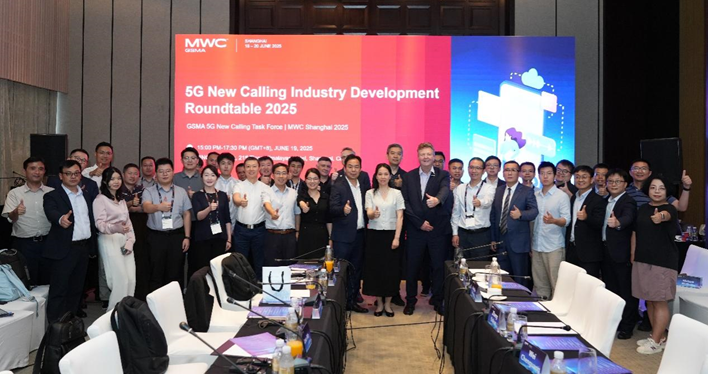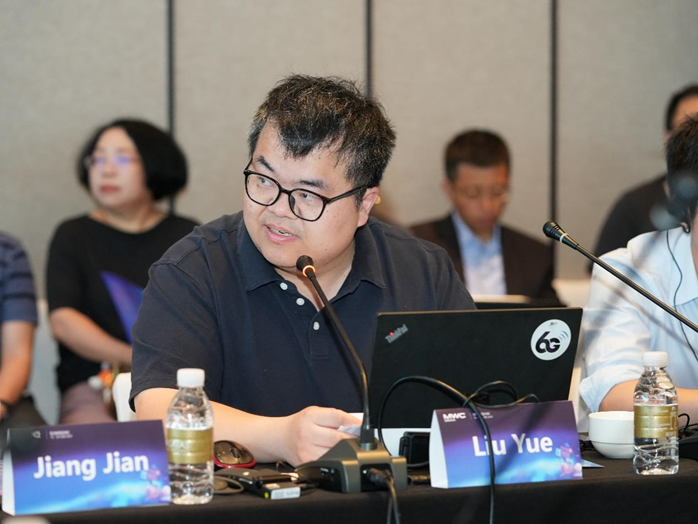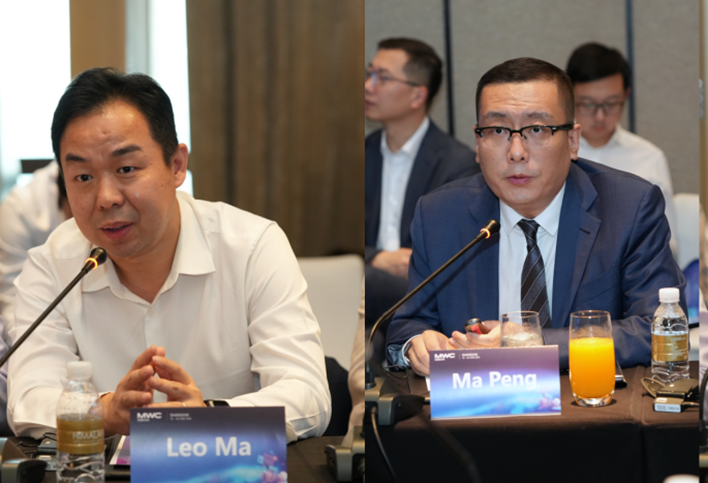On June 19, the 5G New Calling Industry Development Roundtable was successfully held during MWC Shanghai 2025. It was organized by the GSMA 5G New Calling Task Force and supported by China Mobile and Huawei. The event gathered over 70 experts from more than 20 global leading companies, including operators, device manufacturers, chip and terminal vendors, and industry application providers. Participants delved into key topics such as innovative New Calling service scenarios, business model development, commercial deployment strategies, network capability enhancement, and terminal ecosystem collaboration.


Henry Calvert, Head of Networks at GSMA,
hosting the 5G New Calling Industry Development Roundtable
Wei Chenguang, Chair of the GSMA 5G New Calling Task Force, and Vice President of the China Mobile Research Institute, reviewed the task force's annual achievements, and outlined its future roadmap. Since its establishment in 2023, the task force has attracted 16 members, including world-leading operators, terminal vendors, and device manufacturers. It has played a crucial role in fostering industry collaboration, and advancing the New Calling ecosystem. Over the past year, the task force has made significant strides — driving the launch of several key international standards, and conducting in-depth research on business model innovation. These achievements provide a solid foundation for the global, sustainable development of New Calling.

Wei Chenguang, Chair of the GSMA 5G New Calling Task Force and Vice President of the China Mobile Research Institute
Javan Erfanian, Senior Director of Strategy at GTI, presented the results of the world's first New Calling x AI Challenge. The competition drew 98 entries from over 250 participants across various countries and regions, including North America, the Middle East, and the Chinese mainland and Hong Kong. Entries included applications tailored for both individual users and enterprises, spanning cutting-edge areas like intelligent customer service, cross-language communication, guidance on culture and tourism, and digital human interactions. The challenge underscored the transformative potential of AI in reshaping voice service experiences. It provided a rich array of application scenarios and practical use cases to support the development of a globally unified New Calling ecosystem.

Javan Erfanian, Senior Director of Strategy at GTI
Liu Yue, Chief Researcher at the China Mobile Research Institute and Vice Chair of the GSMA IMS DC AS Group, highlighted that as 5G New Calling rolls out commercially in markets like China, business model innovation has become a top priority for the global industry. To support this, the GSMA 5G New Calling Task Force is developing the GSMA White Paper: Study on New Calling Applications and Business Models. This document will systematically review typical global commercial cases, establish a comprehensive value chain analysis framework, and offer diverse business model recommendations. Additionally, Wang Daoheng, Senior Manager at China Mobile Internet, presented an innovative application where AI facilitates communication for the hearing-impaired. This underscores both the social impact and market opportunity of 5G New Calling.

Liu Yue, Chief Researcher at the China Mobile Research Institute and Vice Chair of the GSMA IMS DC AS Group

Wang Daoheng, Senior Manager at China Mobile Internet
Xu Qi, a terminal standards expert at the Mobile and Terminal Technology Research Institute, under the China Telecom Research Institute, discussed the GSMA-initiated IMS DC SDK open-source project. This initiative aims to power a broader array of new services through data channels, reduce barriers to industry adoption, and encourage collaboration and commercial deployment.

Xu Qi, terminal standards expert at the Mobile and Terminal Technology Research Institute under the China Telecom Research Institute
Leo Ma, Vice President of Huawei Cloud Core Network Product Line, pointed out that the commercialization of 5G New Calling encompasses multiple dimensions, including both terminals and networks. He stressed that markets can adopt differentiated strategies based on terminal readiness. In areas where video calls are not yet supported, voice-based AI calling services, such as simultaneous interpretation, are a starting point. In China, DC-capable terminals are gaining momentum, boosting market penetration. Moving forward, DC-based applications are expected to diversify. Regarding future DC evolution, Ma Peng, President of the CS&IMS Domain of Huawei Cloud Core Network Product Line, gave a keynote speech titled "From New Calling to AI Calling, Seize the Entry of AI Service". He stated that Huawei will help operators enhance voice network infrastructure to keep user experiences consistent, and achieve the goal of " all-scenario availability and universal user access ". Huawei also plans to create a robust content and application ecosystem, using standard APIs and a network-service-decoupled architecture. By implementing a unified plug-in framework, Huawei will support agile service rollout. Following a two-phase roadmap — AI-empowered and AI-native — Huawei is steering the transition from AI calling assistants to AI general assistants. This will help operators establish a strategic entry for AI services.

Leo Ma, Vice President of Huawei Cloud Core Network Product Line (left)
Ma Peng, President of the CS&IMS Domain of Huawei Cloud Core Network Product Line (right)
Li Yujia, General Manager of iFLYTEK's New Calling Product Line, emphasized that by using AI to make 5G New Calling applications and scenario-specific calling agents, the industry can create an innovation engine that integrates together technology, practical use cases, and ecosystem collaboration. Developers, terminal vendors, cloud service providers, and industry customers can be brought together to form an open, collaborative innovation chain centered around intelligent agents. This approach streamlines the full cycle — from technological R&D and business monetization, to ecosystem feedback — allowing the communications industry to move from traditional pipeline services to intelligent service delivery. Ultimately, this transformation will unlock a vast new market, driving mutual success for both industries and users.

Li Yujia, General Manager of iFLYTEK's New Calling Product Line
Experts from leading enterprises and industry organizations — including Ant Digital Technologies, BTRC, CAICT, UAE du, Mongolia Mobicom, MTN Group, Omdia, Qatar MOI, Qualcomm, Saudi Arabia Mobily, stc, Samsung, Tele2, UNISOC, vivo, WIT Software, Zhipu AI, and ZTE — engaged in extensive and in-depth discussions. These were based around topics such as service scenario innovation, business models, network optimization, application development, and ecosystem construction. All participants agreed that 5G New Calling will expedite the shift from technological breakthroughs, to widespread commercial adoption. This will occur through innovation across the entire industry chain, and open up new avenues for value creation in the global communications sector.

